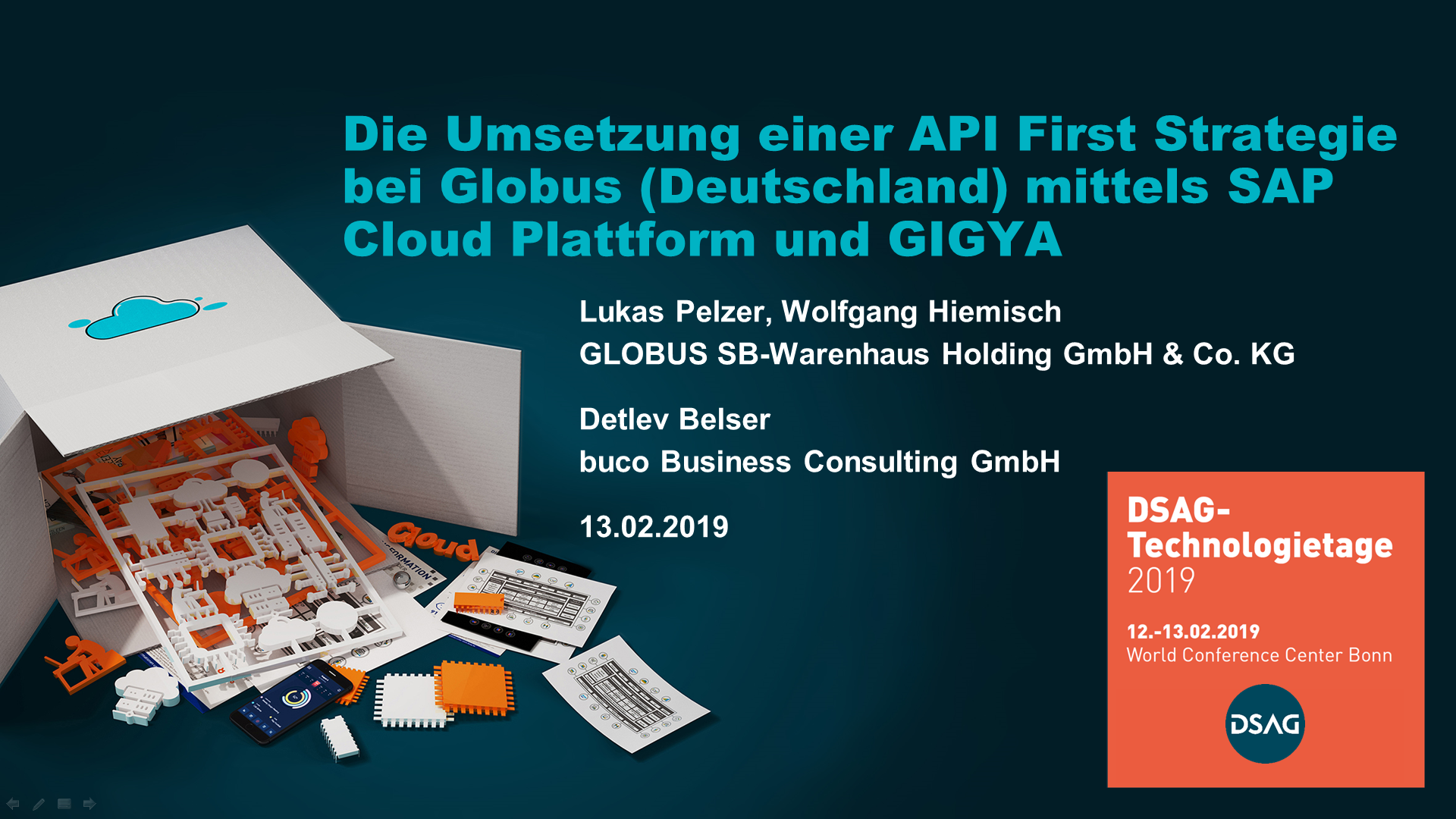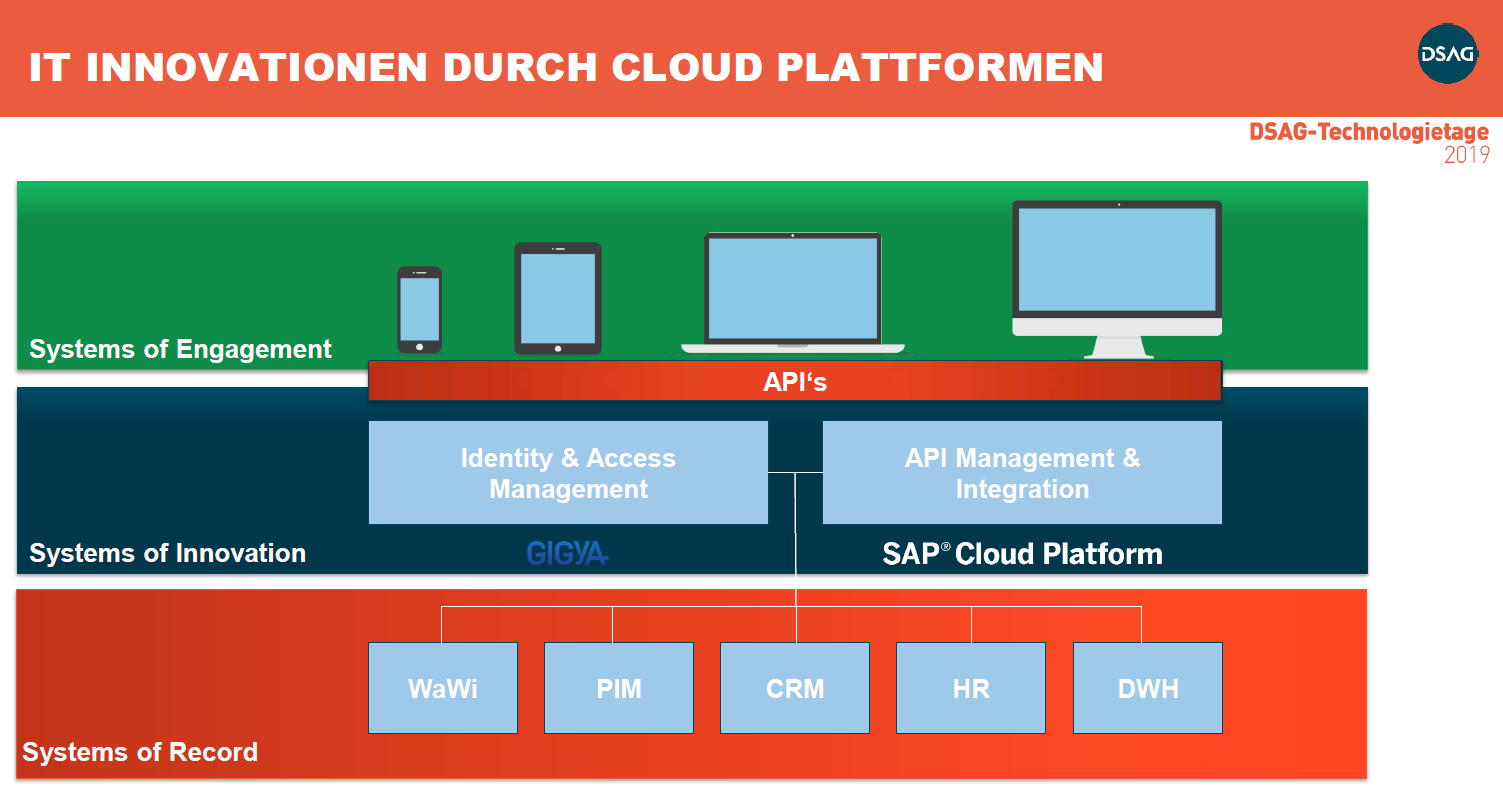DSAG 2019 - API First Strategy
Detlev Belser - 08.02.2019Digital Transformation through API-First Strategy

The API-First strategy is currently often discussed as the future strategy and one of the important building blocks of digital transformations. But what exactly does the API-First strategy mean and how can it be implemented organizationally and technically?
In this blog, we provide insights into a possible implementation, as presented at the DSAG Technology Days 2019 in the Architecture Working Group presentation.
The API-First strategy is essentially based on the premise that data and functionality must ultimately be made available to various channels and applications (Mobile App, Web, Desktop, IoT). With the API-First strategy, APIs should be developed that are consistent and reusable, and can be utilized for all channels.
The use of APIs should be as simple as possible. Business and technical complexity should be encapsulated by the APIs. In this context, we often talk about Developer Experience, which includes additional components such as a Developer Portal for documentation and test calls of APIs. In this environment, it is also very important that SDK generation for various target technologies (Java, PHP, etc.) should be possible.
This approach promises
- Faster implementation of projects across different channels
- Consistent and uniform provision of services in all channels
- Channels are not affected by disruptive system introductions
- Higher degrees of freedom for new ideas
- Simplified and cost-effective operation of the overall solution
In many discussions and articles, the non-functional requirements and operations are neglected, which should actually be a central component of the API-First strategy.
Non-functional aspects include, among others
- Security
- Elasticity (Resilience)
- Automation (Build, Test, Deployment)
- Scalability
- Maintainability
- Monitoring
- Support
However, if you need to fulfill the promises of the API-First strategy, it is absolutely necessary to implement these non-functional aspects, otherwise there is a risk that the API-First strategy will fail.
Engagement Platforms

The implementation of the API-First strategy cannot mean that some APIs are quickly developed and then somehow exposed on the Internet. But what would be a promising approach?
When implementing the API-First strategy, there are almost always two fundamental questions. One concerns the organizational alignment to be able to keep promises such as agility and fast market introduction.
The other question is, of course, how to position oneself technologically.
At this point, the concept of Engagement Platforms is very helpful. Engagement Platforms define a platform specific to a particular business domain. For almost all companies, basic domains can be established, e.g., customers, employees, or suppliers.
All Engagement Platforms have two central components in common
- API Management & Integration
- Identity & Access Management
The API Management and Integration provide the APIs and integration services that can be consumed by the different channels. The API Management covers many of the non-functional aspects so that the API implementations can focus on the business requirements.
The Identity & Access Management is responsible for identities (users) of the respective Engagement Platform and for controlling and managing access rights.
One of the great advantages of the Engagement Platform is that it is relatively easy to define a business owner. For example, it makes sense for the Marketing/Sales department to be responsible for the Customer Engagement Platform.
The offered APIs can usually be well defined at a rough level for a domain.
For example, in the retail sector, the Customer Engagement Platform can be divided as follows:
- Customer Data (Registration and Management)
- Customer Loyalty Program (Customer Cards, Points Program, Vouchers)
- Shopping Options (Stores, Opening Hours, etc.)
- Products and Prices
- Current Offers
- Shopping Lists
- Shopping and Payment
- Delivery
- Complaints
- Opinions / Reviews
- In-Store Customer Experience
The business department should ultimately have sovereignty over the characteristics of the various sub-areas of the Engagement Platform. However, this requires an appropriate organizational alignment. Permanent responsibility structures must be created to ensure the continuous expansion of the platform.
When expanding the platform or for projects in the channels, it is advisable to create cross-functional and cross-departmental teams. These should then include all relevant stakeholders from the business department, IT, and, if necessary, service providers.
Outlook
In the coming weeks, we will provide further blogs that look at the various aspects of the API-First strategy in more detail and offer solution proposals.
Content-wise, it will of course also address the technical solutions, but also the organizational challenges and what a promising organizational alignment could look like.
If you have any questions about the blog post, please feel free to contact me by email at d.belser@buco-consulting.de.